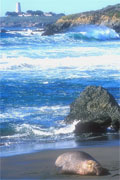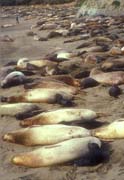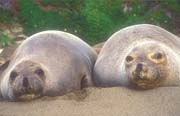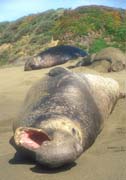“THIRD ANNUAL” BAHAMAS SHARK (AND DOLPHIN) FEST
Monday, June 12th, 2006 at 8:11 am by Ken
May 3 -11, 2006
Hi folks! I went back to the Bahamas last month to take shark images for the third time in three years with the same dive operator, and while all these trips have been very good (hence my repeat visits), this one was the best trip yet! The weather was great (the best they had experienced up to that point in ‘06), the “usual suspects” showed up (lemon, cribbean reef, bull and tiger sharks), the visibility underwater was excellent, and we also had photo opportunities with several other subjects, including dolphins.
Jim Abernethy likes to get “up close & personal” with his photo subjects. That’s Jim in #2 above using this photo technique on a loggerhead turtle (Caretta caretta). You can see from Jim’s photo #3 on the right above that he gets some really dramatic, world-class images this way (I’m malingering in the background), but he’s too busy with his dive operation to really market them very much. Oh, and his “up close…” photo style DOES have an occasional disadvantage, such as when he uses it on tiger sharks…..
#5 and #6
Photos #’s 5 and 6 are a couple of other images Jim Abernethy took of me with a tiger shark. Some of you might recall the close encounters I had on the "2nd Annual" last year with a tiger shark they call Emma, who seemed to be attracted to my yellow snorkel (scroll down to the first two posts at the start of this blog for more on that). I wisely divested myself of that snorkel after a couple of days with sharks on this year’s trip, until close to the end when I needed it for snorkeling with the dolphins.
We did some dives with bull sharks (Carcharhinus leucas), but like last year, they tended to be cautious and keep their distance, which made for limited photo opportunities.
We had some excellent tiger shark (Galeocerdo cuvier) encounters at Tiger Beach–I spotted five tigers at one time, and that means there were more, since you never see them all at once. Jim & the crew kept cautioning us to stay near the stern of the boat on the bottom (only about 15 feet deep) and face outward, keeping the sharks in front of us and in sight. This proved nearly impossible, however, as the boat was often swinging in a long arc, and there were just too many sharks to always be aware of what might be coming up behind you. This had not been a problem on my prior trips because we had never encountered this many tiger sharks at one time. That’s Jim in #21 above (probably trying to tell me I’m not where I’m supposed to be). This was a literal “got your back” situation, and we eventually became pretty good at signaling fellow divers when a tiger was approaching from behind.A couple more shots I took of that loggerhead turtle Jim found.
In addition to the sharks, large groupers were attracted to the bait baskets placed on the reef at the Mother Lode dive site. I THINK #’s 27 & 28 show a yellowmouth grouper (Mycteroperca interstitialis), #29 is a black grouper (Mycteroperca bonaci), and #30 is a nassau grouper (Epinephelus striatus).We dove a site called the Sugar Wreck, which had many nice schools of colorful fish swimming over the remains of this boat. These are french grunts (Haemulon flavolineatum).
We spent our morning on the last day of the trip snorkeling with Atlantic spotted dolphins (Stenella frontalis). My prior trips were both in February, which is not the right time of year to look for dolphins in the Bahamas. The month of May not only offers the probability of better weather (after winter, before hurricane season), but the opportunity to have encounters with these loveable marine mammals as well. At left is a shot of several members of our group taken by Jim Abernethy. We saw many nice sunsets such as #42 above. The swim step at the stern of the boat was a bit hectic during sunsets like this, as several folks who were more adventurous than I attempted to get this shot with a tiger shark biting the bait line in the foreground. Oh well, that’s something to “shoot” for on my “4th Annual” in ‘07…….. That’s it folks! My next trip (June 19-July 10) is to try and shoot the sardine run on the east coast of South Africa. This one is a real roll of the photographic dice, but if I get something you’ll see it on my next blog! Best to all, Kenwww.seaimages.org

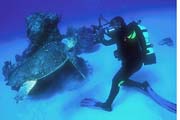
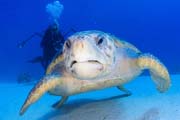
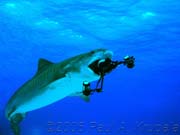

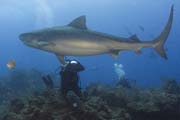




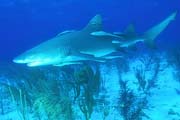











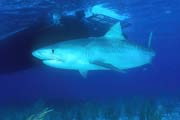


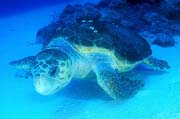

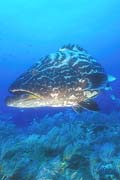







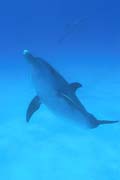

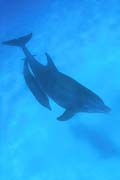




 Permalink
Permalink Filed under:
Filed under: 